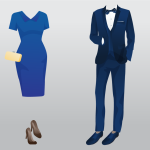Differentiating between dress codes that recommend various types of business attirefor the office is confusing. Online and in company dress codes, the range of business attire options described vary considerably.
For example, some business casual dress codes recommend that employees wear suit coats or jackets to work. Others allow jeans as everyday business attire. With the range of recommendations available, is it any wonder that employees have trouble knowing what is appropriate to wear to work?
You can differentiate dress codes by the degrees of formality in the business attire allowed in the most common employee dress codes. It will help you determine and communicate the appropriate business attire selections for your workplace. The majority of employees just want to fit in, work successfully, and succeed in their careers. A communicated dress code gives them one less factor to worry about or stress over.
You will want to favor simple business attire dress codes that treat employees like adults and leave some clothing decisions to management and employee discretion. But some workplaces require a more sophisticated dress code policy.
The culture of the workplace or the industry expectations drive dress codes in these cases. You would not want to meet with a financial advisor who dressed in jeans and a casual shirt, for example. To project the knowledge and experience necessary to gain your respect as an advisor, they are likely to wear a professional suit.
Appropriate Business Attire for Degrees of Formality in Dress Codes
Casual Dress Code
The preferred level of formality in business attire is casual in many, especially tech related, workplaces. It is also understandable that not every workplace can allow employees to dress casually.
The key differentiators of business attire in a casual workplace include allowing employees to wear jeans, shorts, and athletic shoes daily. Additionally, clothing items such as t-shirts, sandals, and very informal pants and shirts are allowed.
Even in a casual business attire environment, any clothing that has words, terms, or pictures that may be offensive to other employees is unacceptable. Even in a casual work environment, frayed or dirty clothing is not acceptable.
Casual dress codes usually encourage employees to dress up for business meetings, trade shows, and when customers or partners visit the company premises.
- A Relaxed, Casual Dress Code
- Industrial: Construction Photo Gallery
Business Casual Dress Code
In a workplace with a business casual attire dress code, employees dress one step up from casual. Jeans are generally discouraged except on a designated dress down day. Attire such as shorts, sandals, t-shirts, sundresses, and tank tops are not allowed.
In a business casual environment, employees are likely to wear a short or long sleeve shirt with collars, nice pants such as khakis or corduroys, vests, sweaters, casual shoes but not athletic shoes, and jackets and sports coats, on occasion. If you see a tie in day-to-day business casual attire, the employee might wear it with a shirt, rarely a suit coat.
Business casual dress codes may encourage employees to dress up for business meetings, trade shows, and when customers or partners visit the company premises. In high-tech, casual companies, business casual is already the step up.
Smart Casual Dress Code
At various sources online, a smart casual business attire dress code is used interchangeably with business casual business attire. Smart casual dressing is a step up from business casual. Commonly, executives or senior leaders in a workplace with a business casual dress code dress smart casual to kick their clothing up a notch.
Smart casual includes pants or skirts that are a step up from khakis, and are often worn with a jacket or sweater jacket. It also includes outfit-enhancing jewelry, dress shirts, tailored sweaters, vests, ties, matching leather accessories, and leather pull on shoes and boots.
Business Formal Dress Code
Traditional work environments required business formal attire. This attire is still the norm in industries such as professional services, banking, law, accounting, consulting, and in locations such as corporate headquarters.
Business formal attire requires suits or jackets with dress shirts, dresses, ties, formal leather-like shoes, and, in many companies, hose or socks. Business formal attire is the least flexible dress code. In some organizations, employees may be able to dress in high-end smart casual business attire, but others still require the navy, gray, or black dress suits.
Dress Code for Trade Shows
Business attire for trade shows depends on your industry and the norms that have been established at traditional trade shows. In technology trade shows, for example, business casual attire is the norm. Shirts with the company or product logos are also the norm. In the professional services industries, business formal attire is the standard business attire at trade shows.
The best advice for business attire at trade shows is to dress as comfortably as possible in standard industry apparel.


